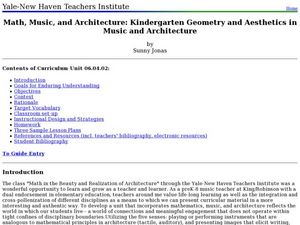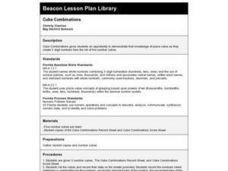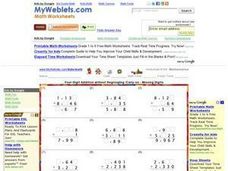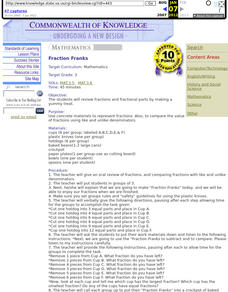Pennsylvania Department of Education
Comparing Sets
Students count back with cubes to model subtraction problems. In this subtraction lesson plan, students compare sets of problems and record their results in a table.
Education World
High, Low, or In Between?
Trios play a card game that reinforces the concepts of number sequence and greater than and less than. Scholars make predictions based on information they know and a single unknown. They see cards drawn by others in the group, but not...
Curated OER
Money in Action
Students become familiar with the various coins in our money system as well as amount of each coin. They help develop their ability to count change and find different ways to show equal amounts.
Curated OER
Everyday Mathematics: Ballpark Estimates
In this estimating practice worksheet, students sharpen their math skills as they learn how to make likely estimates and try the 2 extra practice activities.
Curated OER
Money - Using R & R to Teach Mathematics
Second graders count up coins of money that add up to one dollar. In this money lesson plan, 2nd graders also spend money and keep track of how much they have spent.
Curated OER
Delayed Gratification
Word problems are great for engaging critical thinking skills, and word problems involving money increase a child's financial literacy. Boost your critical and financial thinkers with a multi-step word problem involving money and problem...
Texas Commission on the Arts
The Quarter Fold
Little ones identify the US quarter and explore the concept of one-fourth or one-quarter. Using real coins or coin manipulatives, they divide a square piece of paper into quarters, discuss halves and quarters, and create a design that...
Curated OER
Probability or Ability?
Pupils toss candy and coins using their non-dominant hand while their partners records the results on a probability charts.
Curated OER
Reversing Numbers
Second graders solve a math word problem involving the addition of two digit numbers. They discuss the problem as a class, independently explore the problem, and discuss as a class the solution and how they organized their reversed...
Pennsylvania Department of Education
What Balances?
Students explore another meaning of subtraction as it pertains to the inverse of addition. In this what balances lesson, students identify the concept of subtraction as a balance. Students use subtraction facts to generate addition...
Curated OER
Math, Music and Architecture: Kindergarten Geometry and Aesthetics in Music and Architecture
Students identify and name different geometrical shapes. In this math instructional activity, students distinguish odd from even numbers. They describe the properties of 2 and 3 dimensional objects.
Curated OER
Cube Combinations
Second graders, given 5 number cubes, roll the cubes and record the data.
Curated OER
"ty" number
Second graders encounter the need to assess the code in English for tens is that the word ends in "-ty." They explore the meaning of two or three digit whole numbers to realize that the meaning of words like sixty can be decoded by...
Pennsylvania Department of Education
Seeing Doubles
Students work with dominoes to recognize the number of spots on each side as they relate to addition facts. For this seeing doubles lesson, students make triangle shaped flash cards for the double facts. Students represent the correct...
Curated OER
Making Rectangles
Students study rectangles. In this math lesson, students use numbers, measurements and geometry to draw rectangles of varying sizes.
Curated OER
How Many Months?
Students investigate the first Peter the Mint Eagle, who lived at the Philadelphia Mint from 1830 to 1836. They determine how many months Peter was there and use pictures, numbers, equations, and/or words to explain how they came up with...
Curated OER
One Square Foot
Students identify, describe, count, tally, and graph life found in one square foot of land.
Curated OER
Numbers Up
Students use Legos to build representations of a variety of numbers. They then sort and order their representations and pair them with the written number.
Curated OER
Four-Digit Addition without Regrouping
In this 4 digit addition activity, students solve the 15 four digit addition equations by finding the missing numbers in the equations.
Pennsylvania Department of Education
Multiple Patterns
Young scholars explore patterns that involve doubling numbers. In this multiple patterns lesson, students use objects to explore these patterns while recording them using a table. Young scholars recognize even and odd number patterns...
Pennsylvania Department of Education
Some Special Sums
Pupils study addition. In this math lesson, students solve doubles and doubles plus one addition facts. Pupils roll dice and use the numbers to create addition problems.
Curated OER
Fraction Franks
Young scholars review fractions and fractional parts by making a hotdog meal.
Curated OER
Counting Coins
Students identify the different types of coins. They practice buying objects in the classroom with their coins. They must use different combinations of coins in all situations.
Curated OER
Measure This!
Young scholars estimate the measurement in centimeters for common classroom objects. They check their estimations, discuss the differences and write a paragraph summarizing the activity.
Other popular searches
- Place Value Worksheets
- Place Value Chart
- Decimal Place Value
- Math Place Value
- Money Place Values
- Place Value Decimals
- Decimal Place Value Chart
- Place Value Assessment
- Place Value Chart Template
- Place Value Games
- Math Lessons Place Value
- Manipulatives Place Values

























